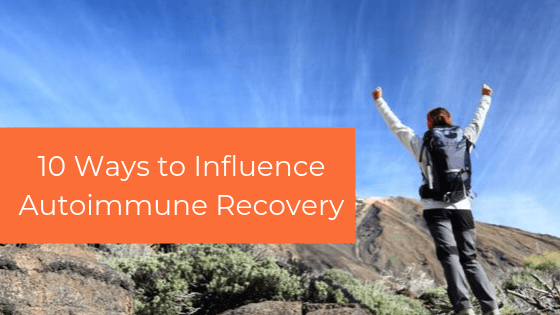
Truth #1: Autoimmune recovery is possible.
Truth #2: There is no one way to get there — everyone is unique. What works for me may not work for you. And, what works for you may not work for me. Don’t let anyone tell you otherwise.
Truth #3: There a multitude of core principles at play and finding your right mix is critical to reversing your condition.
Truth #4: There is one key to this entire process that no one mentions. Stick with me and I will share it with you.
For the past 3 years I’ve had the privilege of working side-by-side with Dr. Susan Blum, one of the foremost authorities on autoimmunity. I work with patients at Blum Center for Health and with individuals through our CoachMe online platform, to implement the four steps of Dr. Blum’s international bestselling book, The Immune System Recovery Plan.
From working with hundreds and hundreds of people, I can tell you this: The Four Steps Work!
You might be wondering, “What are the four steps?” They are: 1) Food as Medicine 2) Learning to Relax 3) Healing the Gut and 4) Supporting the Liver
Within those steps there’s a lot to learn, and it’s within those steps that things get personal. Here’s where YOU come into the equation. If you’ve been struggling with an autoimmune condition and autoimmune recovery, look at little deeper — look within the steps.
Keep your eyes peeled for her new LIVE course: Immune System Strong! Slated to start late September (it will be here before you know it!) Immune System Strong will feature 4 LIVE classes with me that feature tangible next steps that you will be able to implement immediately, as well as community, accountability, group coaching and access to the answers you need on a daily basis. Details will be available soon! Get On The First-To-Know List (even if you’re only a little bit interested), because we’ll be rewarding with an offer that won’t be available to anyone else.) I want the special reward!
10 Ways to Influence Autoimmune Recovery
Eating the Right Foods — You’ve probably heard the phrase, “Food is Medicine.” Indeed it is! And, it can also be your poison. The first step to relieving symptoms, and getting a grip on which foods are right for you, is to do an autoimmune elimination diet. This is not only therapeutic, but it is also diagnostic. When done properly you walk away with a personalized nutrition plan. How does this differ from person to person? Someone with an autoimmune arthritis, for example, may need to remove nightshades. Someone who is struggling with digestive distress may need to consider high lectin foods that might be exacerbating symptoms. The great news is, that once this short-term food plan is complete many people successfully reintroduce favorite foods back into their diet.
Healing your Gut — About 70% of your immune system lives in your digestive tract! Nearly everyone who suffers with an autoimmune condition needs to heal their gut. Think of your gut as a garden with trillions of good bacteria, and includes hundreds of different species. Pretty cool, right? But when all those beautiful good bacteria get infiltrated with bad bacteria, yeast or parasites, the good bacteria get crowded out. And that, right there, can compromise the integrity of your digestive tract lining, creating minuscule breaks in the barrier where food leaks into the bloodstream. This is known as Leaky Gut Syndrome. Healing your gut is a CRITICAL component to healing your autoimmune condition. And the amount of gut damage is different from one autoimmune person to another, and thus the treatment and focus will need to be different, too.
Supporting your Liver — We live in a world filled with toxins that can trigger autoimmune disease and harm the immune system. These include pesticides/herbicides, hormones and plastics in food and water, solvents and mold in our homes and heavy metals in the fish we eat and water we drink. Others can come from cosmetics and products we use at home. At Blum Center for Health, we also believe that some relationships, home and work environments and thoughts can be toxic and have a negative impact on the body. We highly recommend detoxing at least once a year. This is another place where things get personal – your toxin exposure is going to be different than everyone else’s, and how much detox you need will be different, too.
Taking the Right Supplements — Targeted supplements facilitate healing, reduce inflammation, heal the gut, and remove toxins. It’s important to use medical grade supplements that do not contain fillers, preservatives, additives, gluten, dairy, soy or corn. You’ve got to check labels carefully. You could very well be putting something in your body that’s contributing to your autoimmune condition!
Learning to Relax — Stress, even low grade stress (you know, they kind we wave away, like having to make lunch everyday for your kids to take to school) fuel the fire of autoimmunity. Even good stress, like getting ready to go on vacation, can cause a flare. Many people will get on board with the food plan, and start taking the appropriate supplements, but have a hard time implementing a stress reduction process. This may very well be the most difficult part of an autoimmune program. And this is where coaching can make all the difference in the world. In a world that’s built on distraction and endless motion it can be difficult and uncomfortable to be quiet with oneself.
Implementing Exercise When You Don’t Feel Well — Exercise is one of those “loops”— you don’t feel well so you don’t exercise (don’t worry, I feel the same) and when you don’t exercise you don’t get its anti-inflammatory benefits. Drop all the ideals you have about exercise: the person running on a treadmill, the women pushing weights at the gym, the man doing headstands in a yoga class, the people doing hardcore spin. You don’t have to go to the gym! You don’t have to run on a treadmill! You don’t have to do weights! You just have to start with moving. Start slow. Start low. Start with something you enjoy. Just start.
Getting enough Sleep — The research is clear: Lack of sleep or poor sleep impacts just about every system in your body, and increases inflammation. It increases your risk of autoimmunity and if you already have an autoimmune condition it impedes your ability to heal it. And by the way, lack of proper sleep drives sugar cravings and carb cravings, which makes it nearly impossible to stick to a healthy, anti-inflammatory food plan!
Learning to Say No — This is not scientific, but this is my observation in working with hundreds and hundreds of women: You can heal your autoimmune condition by holding your boundaries firm. No more giving away your time, no more saying yes to things that don’t serve you. Taking care of yourself means saying no. Or in other words, when you say no, you give yourself the space you need to heal. Want to read more on this subject? Check out 8 Reasons All Women Need Non-Negotiable Self-Care
Understanding Hidden Infections: Doing everything and still symptomatic? You may need additional testing. Functional medicine will help you get to the root of the problem.
AND FINALLY:
The KEY that I promised you – CONSISTENCY:
Yes, consistency! Taking imperfect action daily. Notice I said “imperfect.” We’re not trying to be perfect. In fact, it’s impossible to be perfect. It’s not all or nothing. When someone starts something new, they often give up. If they can’t do it “right,” they don’t do it at all. (Think New Year’s Eve resolutions. Done by February 1st!) You can be consistent. You can even learn to be consistent if it’s eluded you in the past. It’s all about figuring out your personal plan … a combination of what you need right now and the baby steps you need to get there.
And, this is where it’s important to have a coach or a coaching program so that you’re not figuring it all out alone.
Are you ready to begin reversing your autoimmune condition? Join Dr. Blum and me for Immune System Strong! Get On The First-To-Know List (even if you’re only a little bit interested), because we’ll be rewarding with an offer that won’t be available to anyone else.) I want the special reward!
Meet Melissa: Melissa Rapoport is the Manager of Health Coaching and Lifestyle Programming at Blum Center for Health in Rye Brook, NY. She combines her graduate work in Developmental Psychology with her education in nutrition, health and coaching to create highly individualized programs that result in lifetime change. A contributing author to three international bestselling books, Melissa’s greatest joy is her relationship with her two daughters.




